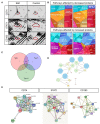Proteomic Profiling Unravels a Key Role of Specific Macrophage Subtypes in Sporadic Inclusion Body Myositis
- PMID: 31143183
- PMCID: PMC6522546
- DOI: 10.3389/fimmu.2019.01040
Proteomic Profiling Unravels a Key Role of Specific Macrophage Subtypes in Sporadic Inclusion Body Myositis
Abstract
Unbiased proteomic profiling was performed toward the identification of biological parameters relevant in sIBM, thus giving hints about the pathophysiological processes and the existence of new reliable markers. For that purpose, skeletal muscle biopsies from 13 sIBM and 7 non-diseased control patients were analyzed with various methods, including liquid chromatography coupled to tandem mass spectrometry (four patients). Subsequent data analysis identified key molecules further studied in a larger cohort by qPCR, immunostaining, and immunofluorescence in situ. Proteomic signature of muscle biopsies derived from sIBM patients revealed the chaperone and cell surface marker CD74, the macrophage scavenger molecule CD163 and the transcription activator STAT1 to be among the highly and relevantly expressed proteins suggesting a significant contribution of immune cells among the myofibers expressing these markers. Moreover, in silico studies showed that 39% of upregulated proteins were involved in type I or mixed type I and type II interferon immunity. Indeed, further studies via immunohistochemistry clearly confirmed the prominent involvement of the key type I interferon signature-related molecules, ISG15 as well as IRF8 with MHC class II+ myofibers. Siglec1 colocalized with CD163+ macrophages and MHC class II molecules also co-localized with CD74 on macrophages. STAT1 co-localized with Siglec1+ macrophages in active myofibre myophagocytosis while STAT6 colocalized with endomysial macrophages. These combined results show involvement of CD74, CD163, and STAT1 as key molecules of macrophage activation being crucially involved in mixed and specific type I interferon, and interferon gamma associated-pathways in sIBM. On a more general note, these results also highlight the type of immune-interaction between macrophages and myofibers in the etiopathology of sIBM.
Keywords: CD163; CD74; SIGLEC1; STAT1; STAT6; muscle proteomics; type I interferon (IFN).
Figures




Similar articles
-
The role of interferons type I, II and III in myositis: A review.Brain Pathol. 2021 May;31(3):e12955. doi: 10.1111/bpa.12955. Brain Pathol. 2021. PMID: 34043262 Free PMC article. Review.
-
The immune system in sporadic inclusion body myositis patients is not compromised by blood-flow restricted exercise training.Arthritis Res Ther. 2019 Dec 18;21(1):293. doi: 10.1186/s13075-019-2036-2. Arthritis Res Ther. 2019. PMID: 31852482 Free PMC article. Clinical Trial.
-
A subpopulation of CD163-positive macrophages is classically activated in psoriasis.J Invest Dermatol. 2010 Oct;130(10):2412-22. doi: 10.1038/jid.2010.165. Epub 2010 Jun 17. J Invest Dermatol. 2010. PMID: 20555352 Free PMC article.
-
Upregulated inducible co-stimulator (ICOS) and ICOS-ligand in inclusion body myositis muscle: significance for CD8+ T cell cytotoxicity.Brain. 2004 May;127(Pt 5):1182-90. doi: 10.1093/brain/awh148. Epub 2004 Mar 26. Brain. 2004. PMID: 15047591
-
The macrophage scavenger receptor CD163.Immunobiology. 2005;210(2-4):153-60. doi: 10.1016/j.imbio.2005.05.010. Immunobiology. 2005. PMID: 16164022 Review.
Cited by
-
Inclusion body myositis, viral infections, and TDP-43: a narrative review.Clin Exp Med. 2024 May 2;24(1):91. doi: 10.1007/s10238-024-01353-9. Clin Exp Med. 2024. PMID: 38693436 Free PMC article. Review.
-
The role of interferons type I, II and III in myositis: A review.Brain Pathol. 2021 May;31(3):e12955. doi: 10.1111/bpa.12955. Brain Pathol. 2021. PMID: 34043262 Free PMC article. Review.
-
Novel Genetic and Biochemical Insights into the Spectrum of NEFL-Associated Phenotypes.J Neuromuscul Dis. 2024;11(3):625-645. doi: 10.3233/JND-230230. J Neuromuscul Dis. 2024. PMID: 38578900 Free PMC article. Review.
-
Complement and MHC patterns can provide the diagnostic framework for inflammatory neuromuscular diseases.Acta Neuropathol. 2024 Jan 12;147(1):15. doi: 10.1007/s00401-023-02669-8. Acta Neuropathol. 2024. PMID: 38214778 Free PMC article. Review.
-
Metabolic shift underlies recovery in reversible infantile respiratory chain deficiency.EMBO J. 2020 Dec 1;39(23):e105364. doi: 10.15252/embj.2020105364. Epub 2020 Oct 31. EMBO J. 2020. PMID: 33128823 Free PMC article.
References
Publication types
MeSH terms
Substances
LinkOut - more resources
Full Text Sources
Research Materials
Miscellaneous

